DHT: The Hormone Behind Your Hair Loss

Sommaire
What is DHT?
Androgenetic alopecia, commonly known as male or female pattern baldness, affects millions worldwide. This gradual hair loss is primarily caused by an oversensitivity of hair follicles to a hormone called dihydrotestosterone, or DHT. Understanding the role of DHT is crucial for grasping the causes of hair loss and the available treatments.
DHT is a hormone derived from testosterone, produced when an enzyme called 5-alpha reductase converts testosterone into DHT. This conversion takes place mainly in certain tissues such as the prostate, testes, hair follicles and skin.
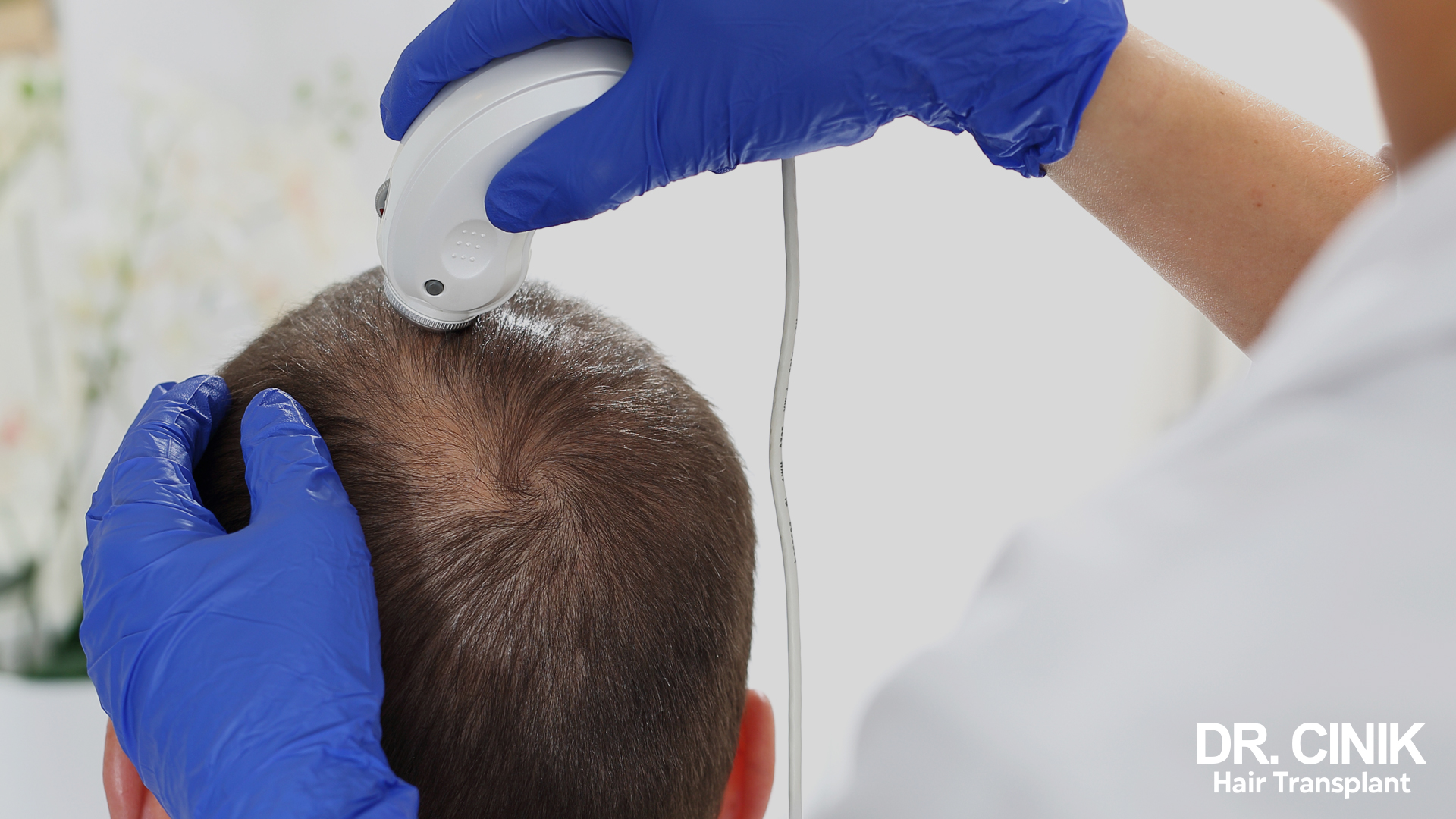
During puberty, testosterone and DHT play a key role in the development of male characteristics such as beard growth, pubic hair, muscle development, and body hair. However, in adulthood, excessive sensitivity of hair follicles to DHT can lead to progressive hair loss.
In men, normal testosterone levels range from 3 to 10 ng/mL, while normal DHT levels are between 0.3 and 0.85 ng/mL. In women, normal testosterone ranges from 0.15 to 0.7 ng/mL, with DHT levels between 0.006 and 0.036 ng/mL. Even at these lower levels, DHT can cause hair loss in genetically predisposed women.
How DHT Affects Hair and Causes Hair Loss
Hair follicles have receptors on their surface to which DHT can bind. When DHT attaches to these receptors, it triggers a series of reactions that disrupt the hair’s normal growth cycle:
- The hair growth phase (anagen) gradually shortens
- The resting (catagen) and shedding (telogen) phases lengthen
- Hairs have less time to grow and fall out more quickly
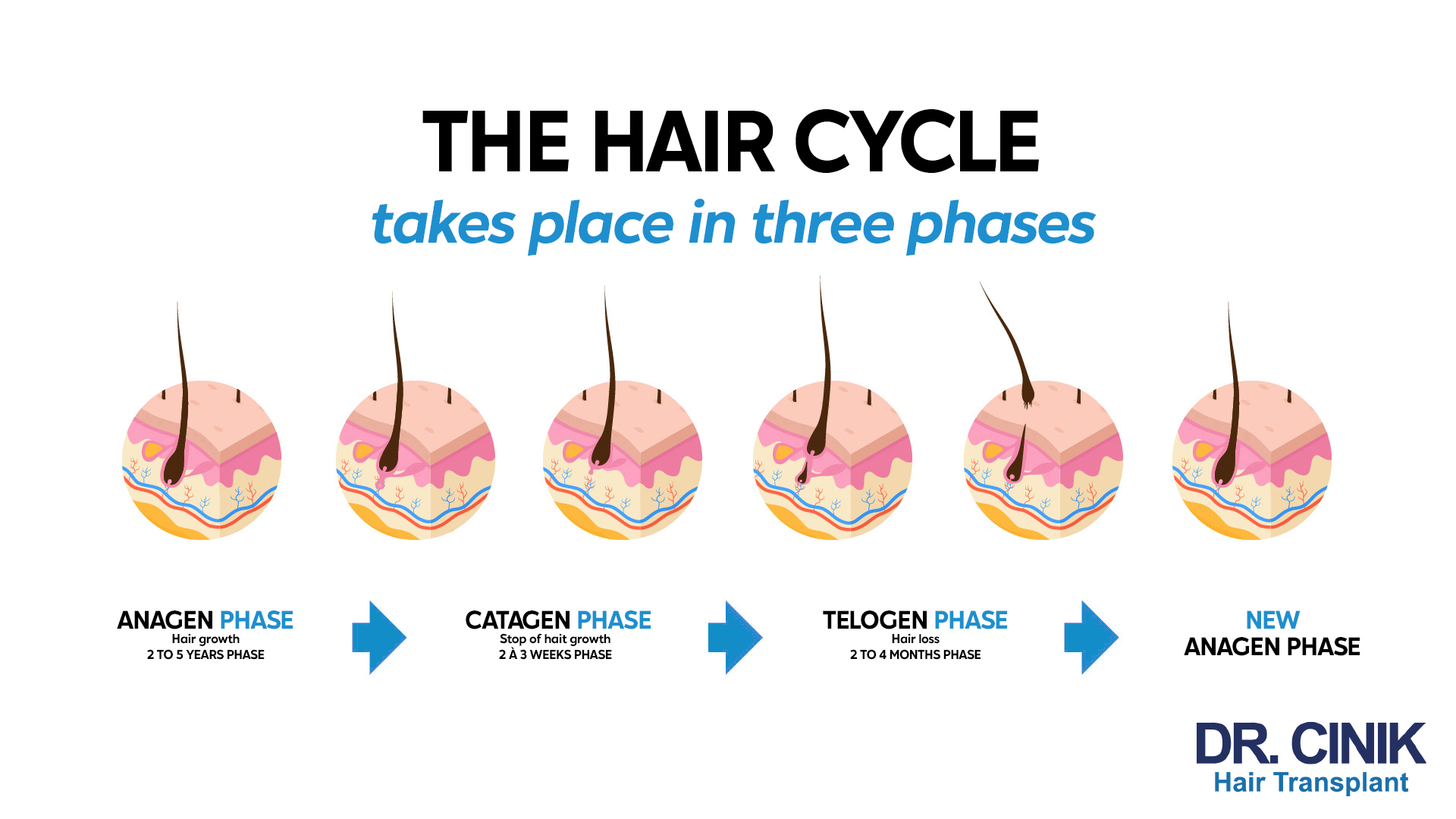
This gradual disruption of the hair cycle is what leads to the progressive onset of androgenetic alopecia. Over time, hair follicles shrink under the influence of DHT and produce increasingly thinner and shorter hairs – a phenomenon known as miniaturization. Eventually, thick, pigmented hairs are transformed into fine, colourless vellus hairs. The follicles may become completely inactive, leaving only empty pores on the scalp.
In men, this process of miniaturization and hair loss follows a characteristic pattern classified by the Norwood Hamilton scale:
- Recession of the frontal hairline at the temples on either side of the forehead (stages 1 to 3)
- Appearance of a bald spot on the crown (vertex) that gradually widens (stages 3 to 5)
- Joining of the receded frontal hairline and expanding vertex, leaving only a horseshoe-shaped fringe of hair at the back and sides of the scalp (stages 6 and 7)
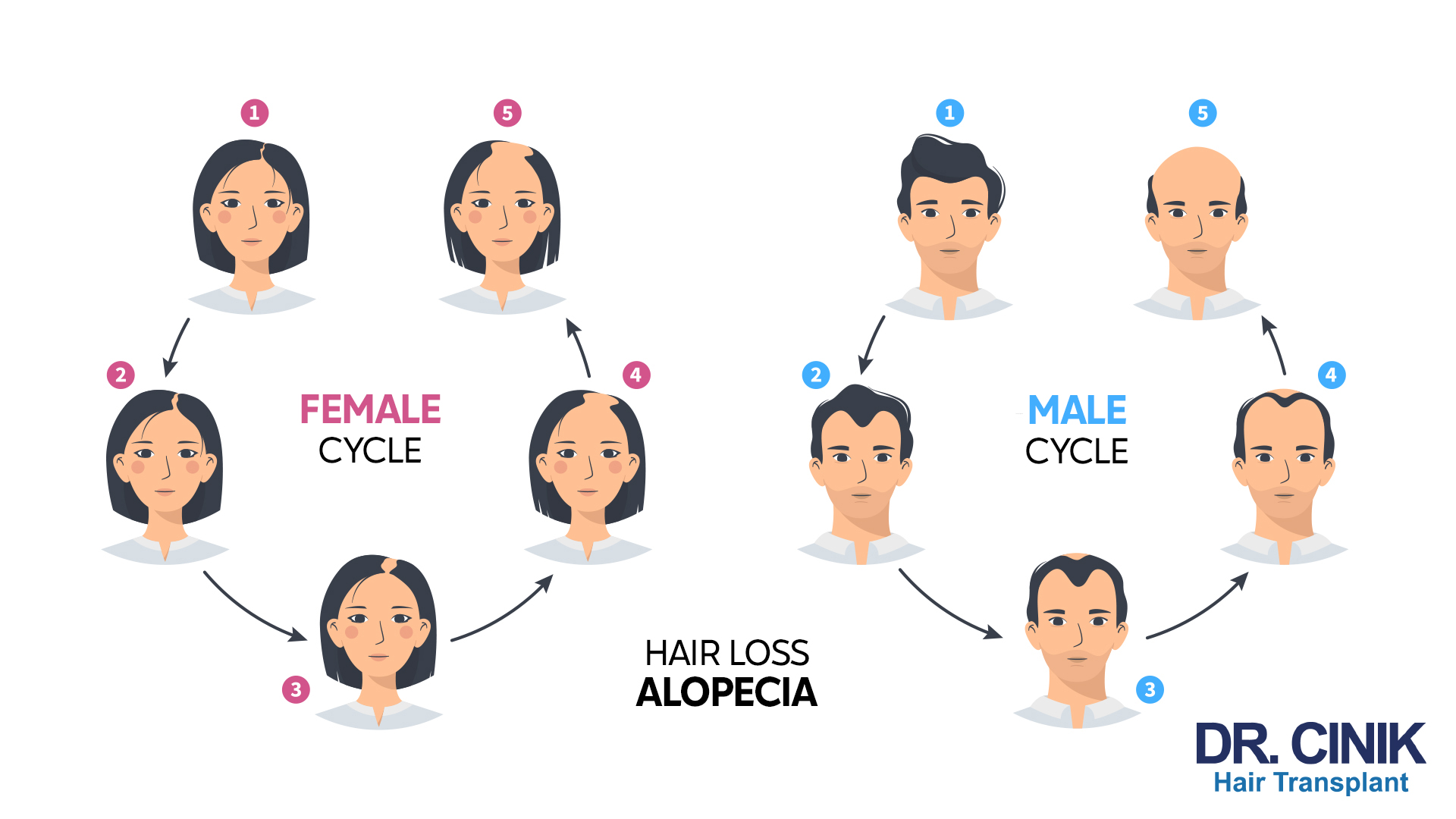
In women, hair loss typically begins later than in men and follows a different pattern, classified by the Ludwig scale:
- Stage I: Diffuse thinning of hair along the midline of the scalp
- Stage II: Widening of the thinning area on either side of the midline
- Stage III: Significant hair loss over the entire top of the scalp, with a persisting narrow frontal fringe
Unlike men, recession at the temples and complete baldness are uncommon in women.
The scalp areas affected by androgenetic alopecia are those where hair follicles are most sensitive to the effects of DHT. This sensitivity is largely genetically determined, which explains the hereditary nature of the condition and the variations in severity between individuals.

Why Some People Lose More Hair Than Others
Hair loss from androgenetic alopecia varies considerably from person to person. Some individuals are affected as early as their 20s, while others only experience it much later in life. The extent of hair loss also differs widely. Two main factors account for these differences: genes and hormones.
Individual Genetic Predisposition
Androgenetic alopecia is a condition influenced by many genes. Certain genetic variations determine the sensitivity of hair follicles to the harmful effects of DHT. The most important gene is the androgen receptor (AR) gene, located on the X chromosome.
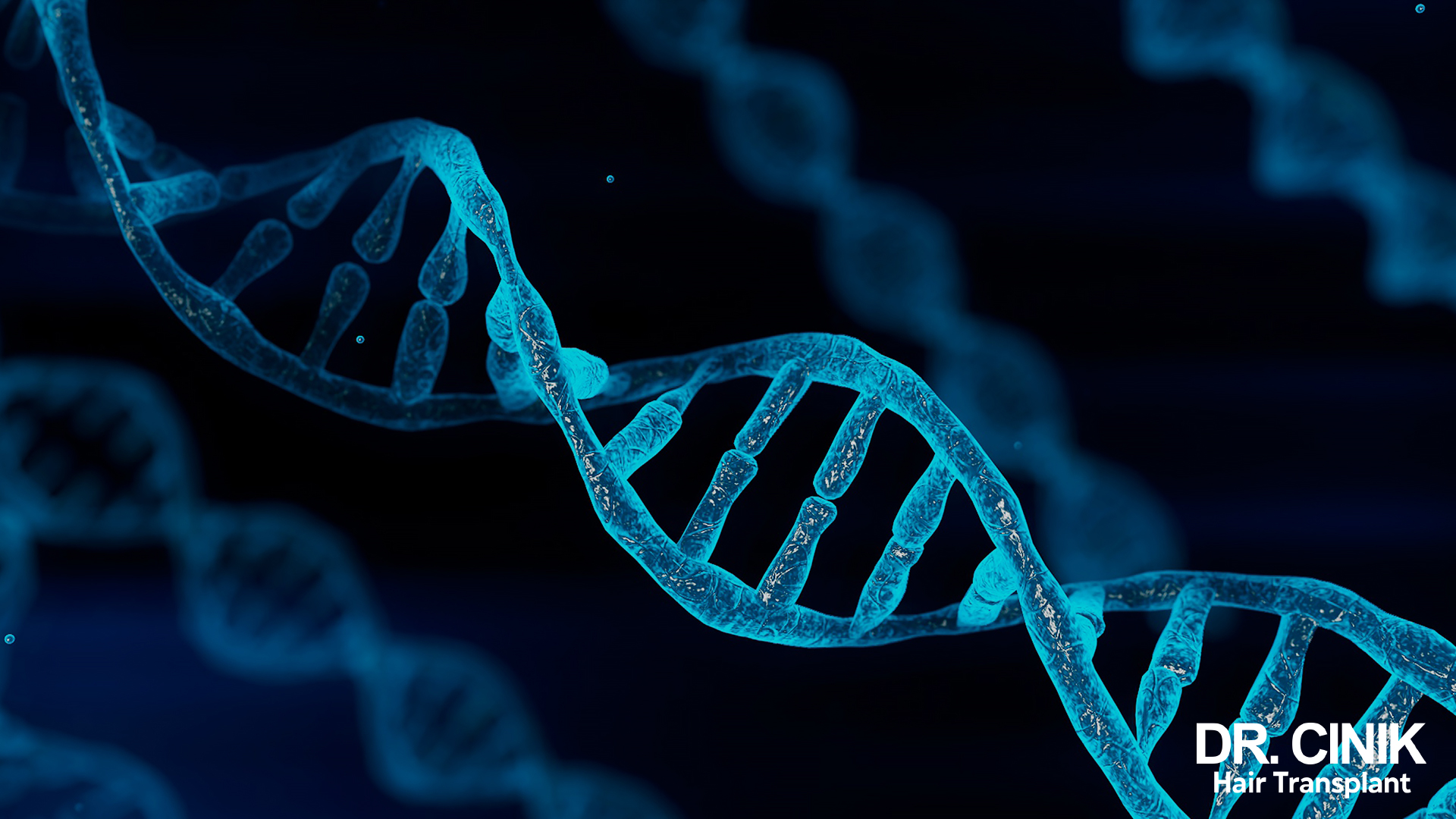
Studies have shown that men possessing certain versions of the AR gene, characterised for example by a reduced number of glycine amino acid repeats, have a higher risk of developing early-onset alopecia. Up to 40% of the genetic risk may be linked to these AR gene variations. Other genes involved in hair growth, such as the WNT10A gene, also play a role.
Together, these genetic factors modulate the response of hair follicles to DHT and explain why some people are genetically more predisposed than others to androgenetic alopecia.
Hormonal Imbalances in Women
In some women, an excess of androgens called hyperandrogenism can promote hair loss. This excess may be due to conditions such as polycystic ovary syndrome. Moreover, after menopause, declining oestrogen levels remove their protective effect on hair follicles, making them more vulnerable to the impact of DHT.
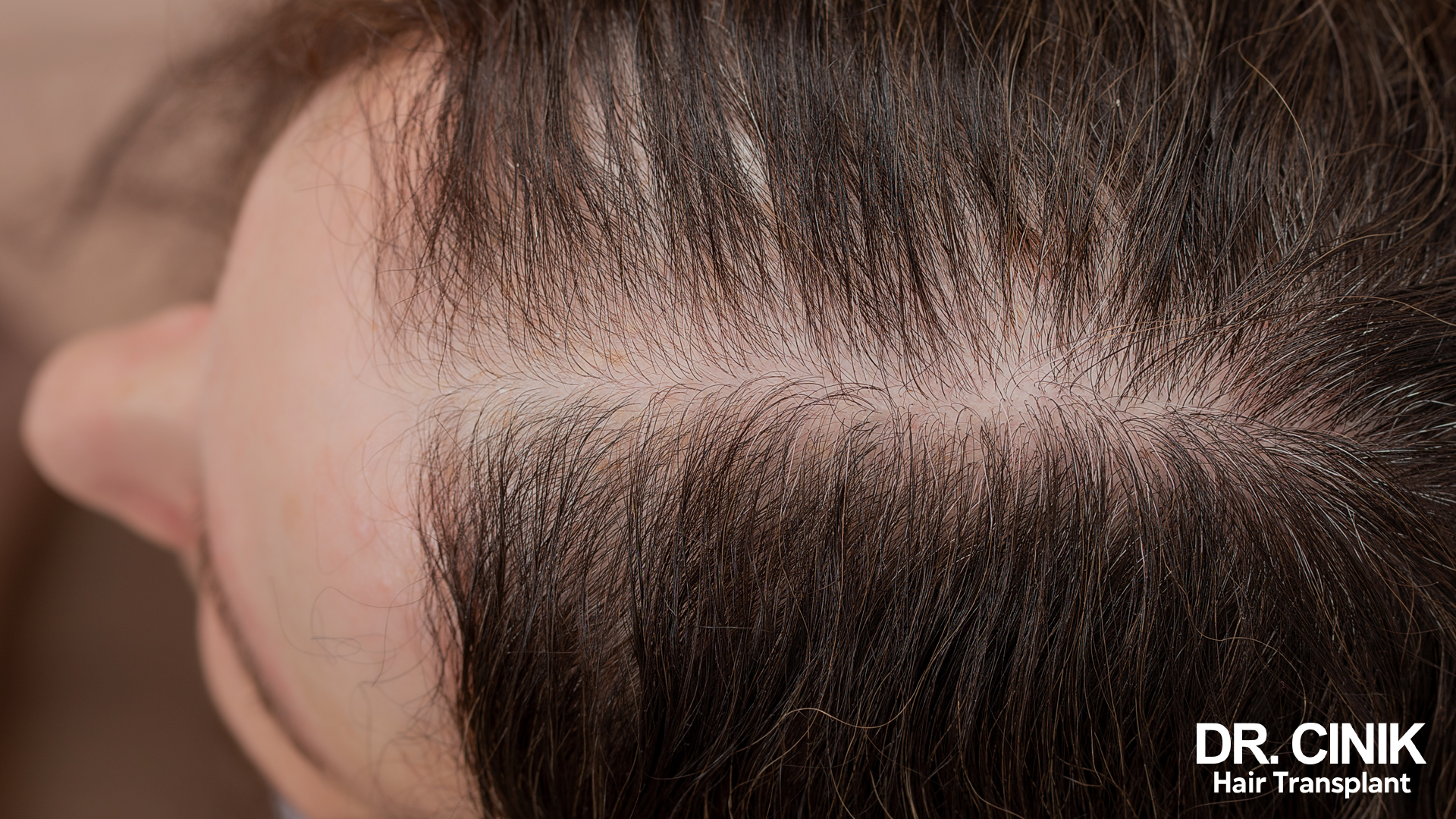
Age-related or disease-related hormonal imbalances can therefore exacerbate a woman’s genetic susceptibility to androgen-induced hair loss.
Other Factors That Promote Hair Loss
Besides genes and hormones, other elements influence hair health and growth:
- Ageing and its effect on hair follicles With age, hair follicles tend to shrink and produce thinner, shorter hairs. This natural ageing of the follicles compounds the impact of DHT and accelerates hair loss in genetically predisposed individuals.
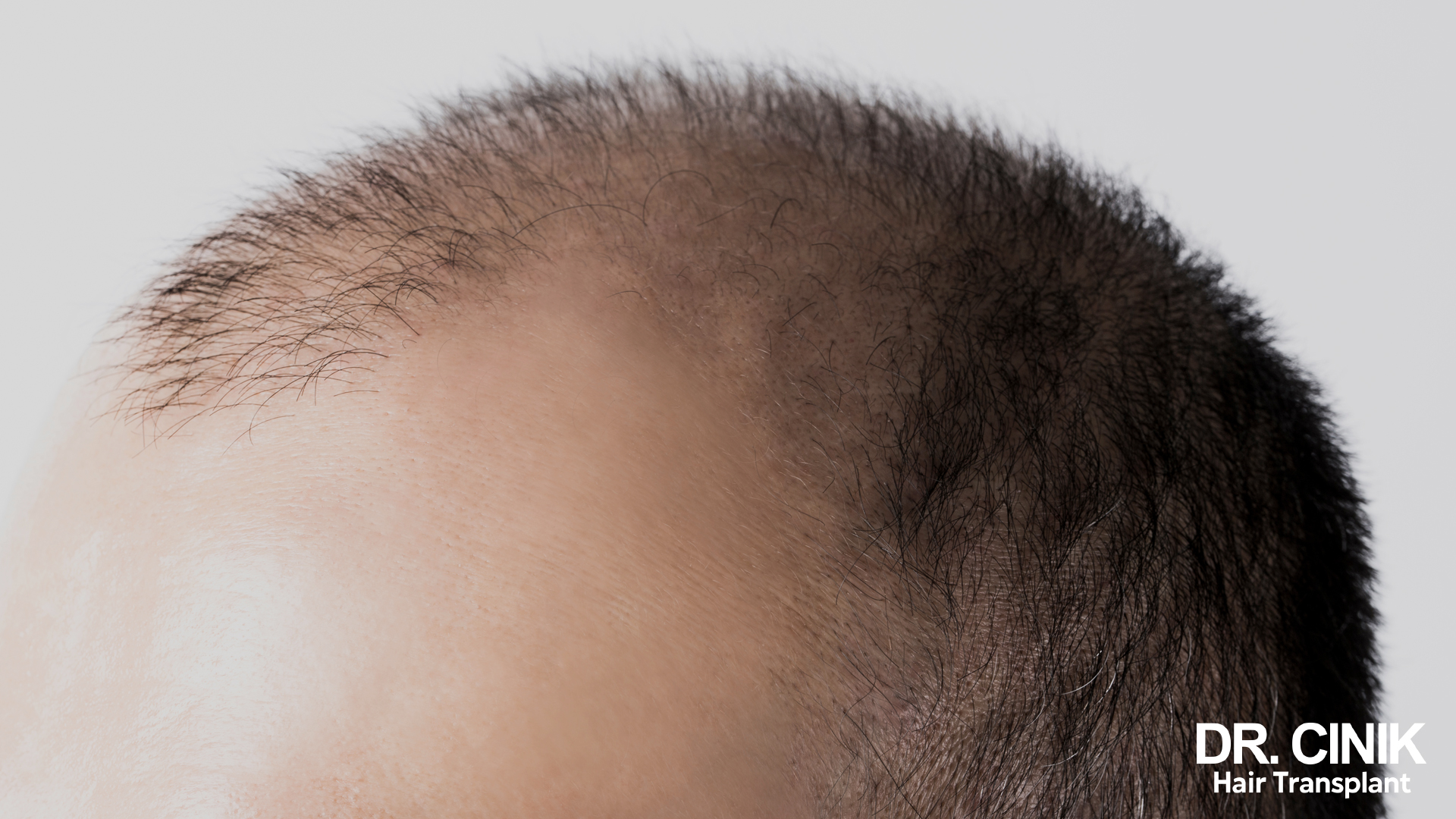
- Chronic stress and nutritional deficiencies Intense, prolonged stress can trigger hair loss through a mechanism called telogen effluvium. Additionally, deficiencies in iron, zinc, B vitamins or protein can weaken hair and promote shedding. Stress and deficiencies often act as aggravating factors in androgenetic alopecia.
Treatments to Counter the Effects of DHT on Hair
Nowadays, many therapeutic options exist to counter the harmful effects of DHT on hair follicles in androgenetic alopecia. These treatments work at different levels: by reducing DHT production, blocking its action on follicles, or directly stimulating hair regrowth.
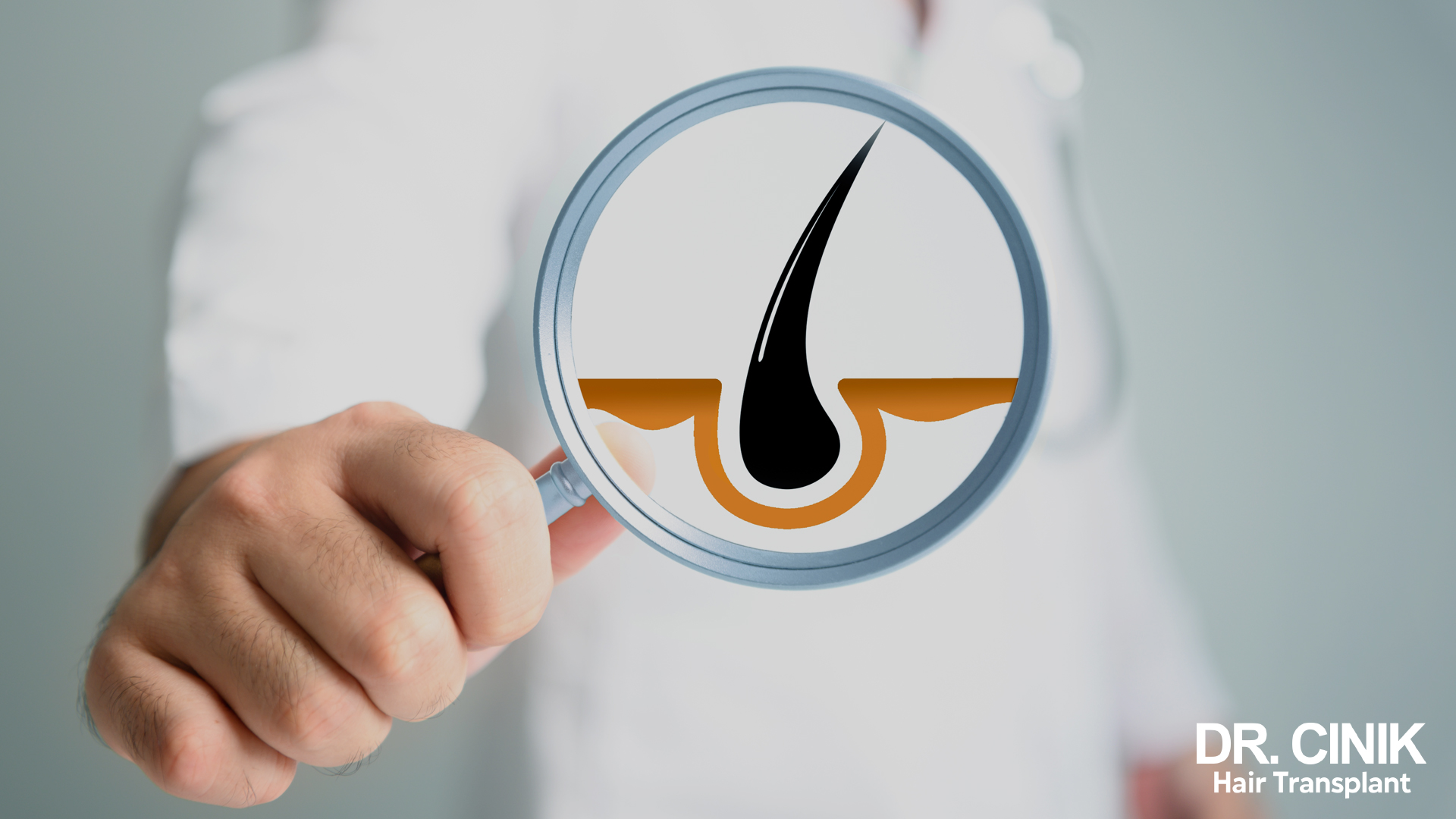
Medications That Reduce DHT Production
- Finasteride (Propecia) and dutasteride (Avodart) are inhibitors of 5-alpha reductase, the enzyme that converts testosterone to DHT. Taken orally, they lower circulating DHT levels and scalp DHT concentration, thereby halting follicle miniaturization. Finasteride at a dose of 1 mg/day has proven effective in men, enabling hair regrowth in 48% of treated patients. The more potent dutasteride is used at a dose of 0.5 mg/day. However, these medications can cause side effects such as sexual problems (reduced libido, erectile dysfunction), limiting their use.
- Topical formulations of finasteride and dutasteride are under development to avoid their systemic effects while preserving local efficacy. Studies have shown that a 0.25% finasteride solution applied twice daily was as effective as oral administration, with fewer adverse effects.
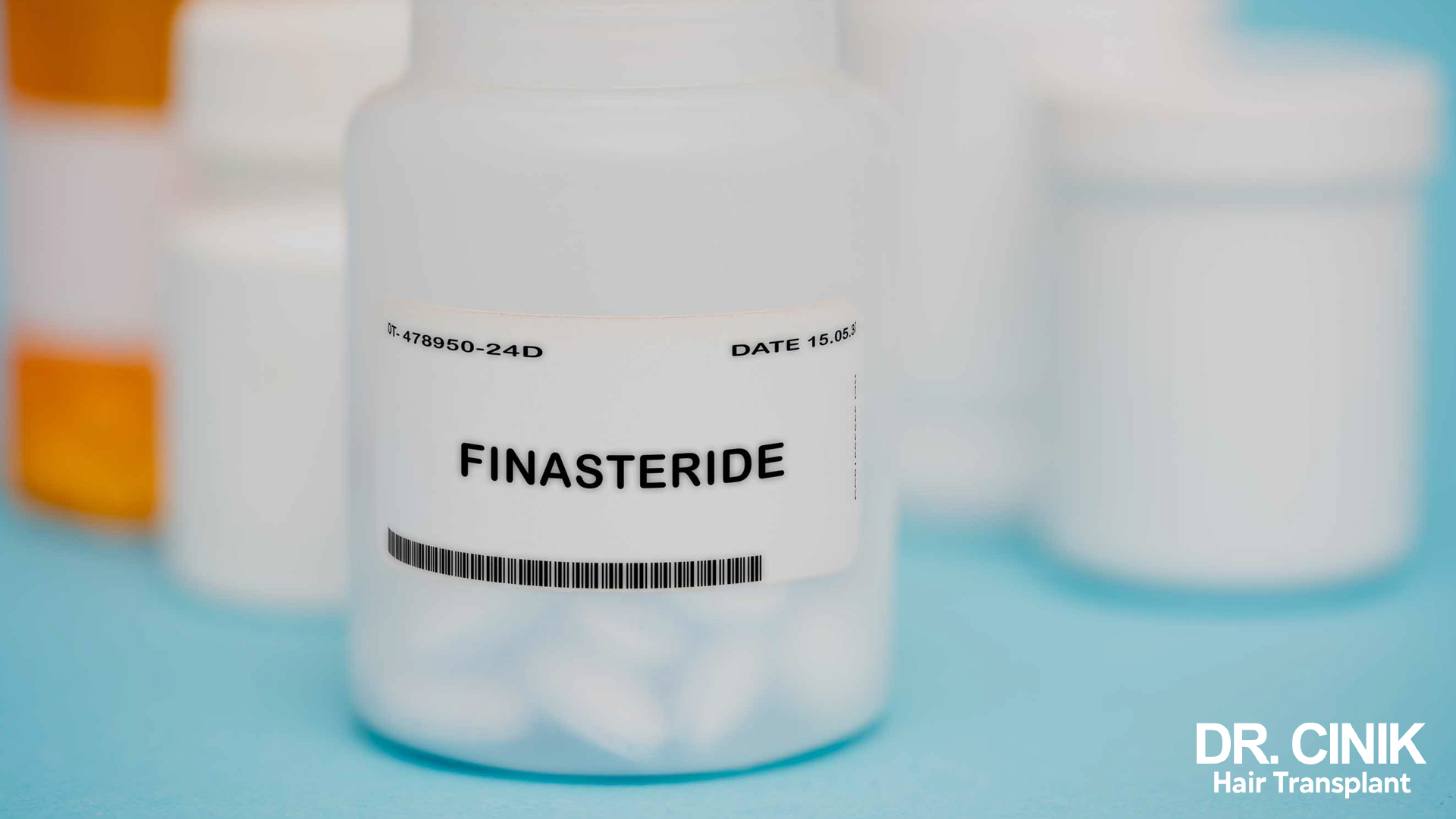
Medications That Block DHT Action on Follicles
- Spironolactone is an anti-androgen commonly used in women to treat androgenetic alopecia and hirsutism. By blocking androgen receptors, it opposes DHT’s miniaturizing effect on hair follicles. Taken orally at doses of 25 to 200 mg/day, it reduces shedding and stimulates regrowth in 44% of treated women. Its use is limited in men due to feminizing effects (gynecomastia).
- Fluridil is another anti-androgen available as a 2% topical solution. It acts as a “shield” preventing DHT from binding to hair follicle receptors. Several studies have shown its efficacy in treating androgenetic alopecia in both men and women, with good local tolerance.
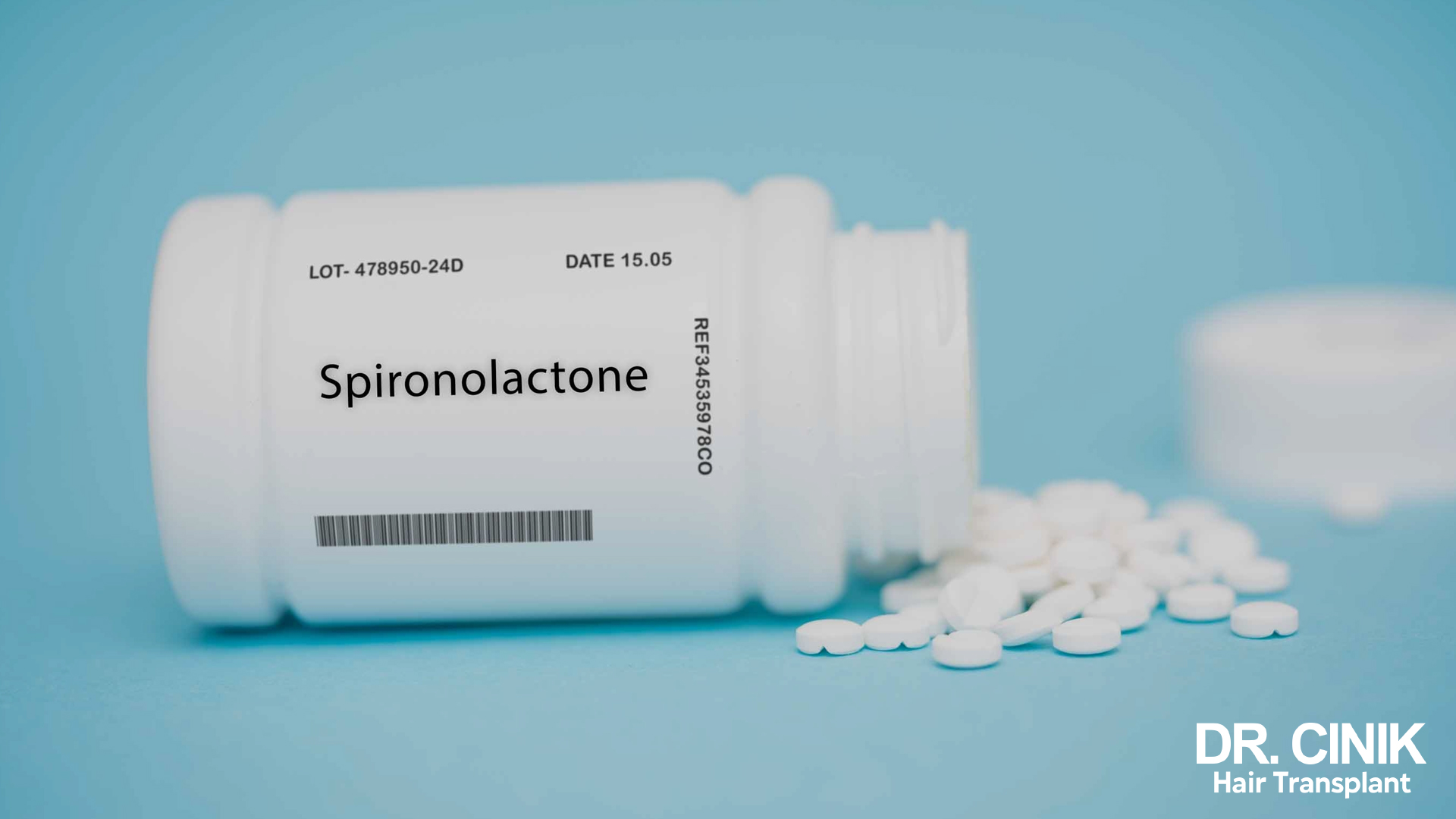
Topical Treatments to Stimulate Hair Regrowth
- Minoxidil remains the go-to topical treatment for androgenetic alopecia. Its exact mechanism of action is not fully understood, but it appears to act as a potassium channel opener, enhancing local microcirculation and prolonging the anagen phase of the hair cycle. Applied twice daily as a 2% solution in women and 5% in men, it produces visible regrowth in 30 to 60% of cases after 6 to 12 months of treatment. It can cause some local side effects (irritation, itching) and must be used long-term to maintain efficacy.
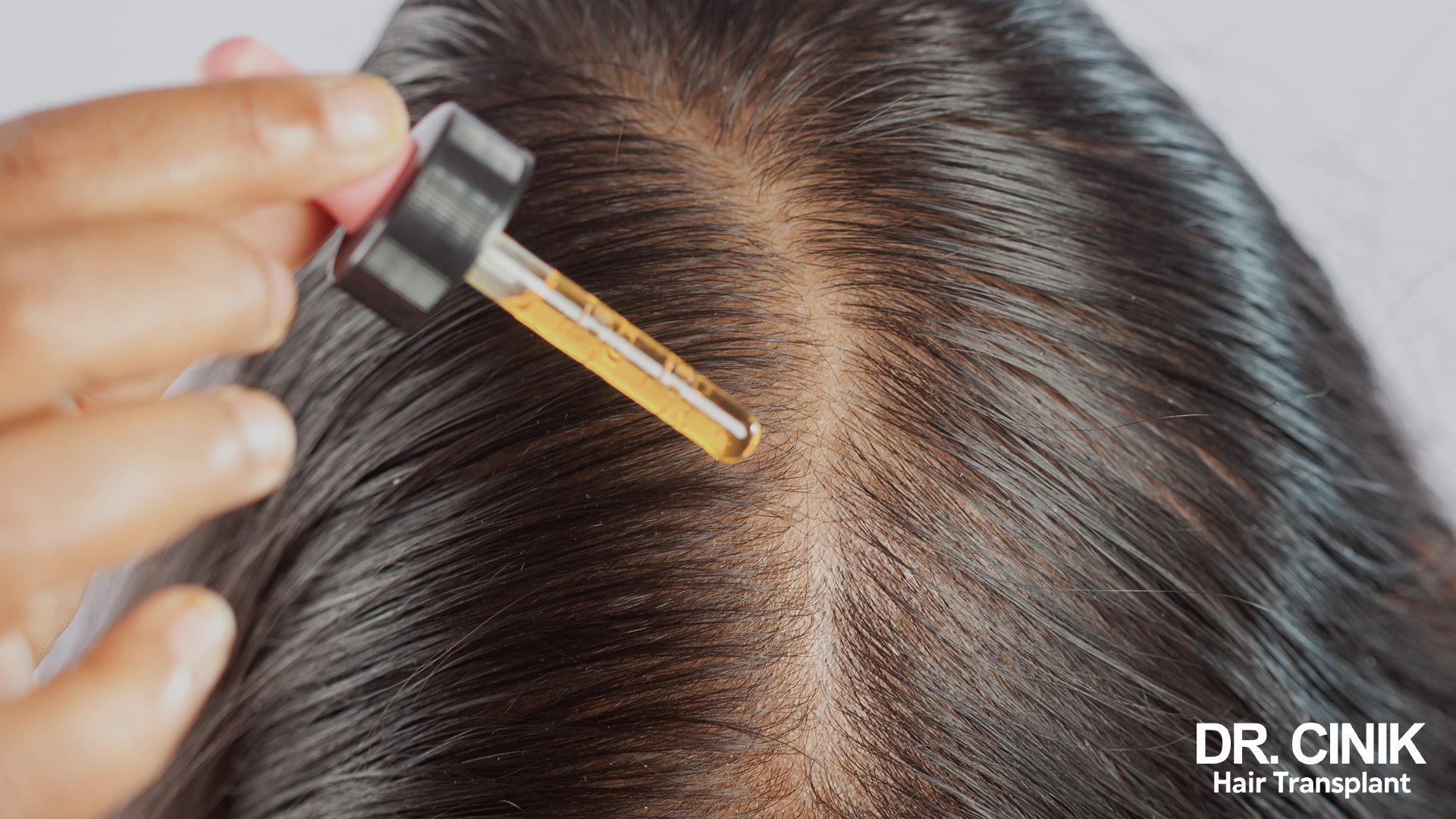
- New topical formulations aim to potentiate minoxidil’s effect by combining it with other active ingredients:
- 5% minoxidil + 0.1% finasteride solution showed superior efficacy to minoxidil alone in a phase 3 clinical trial.
- Minoxidil + retinoic acid (vitamin A) may accelerate regrowth and increase hair density.
- Minoxidil + BMAO (ortho-biotinyl-l-methionine) may help maintain hair in the anagen phase.
- Minoxidil in foam or spray form may improve penetration and bioavailability.
- Injections of platelet-rich plasma (PRP), obtained by centrifuging the patient’s blood, deliver growth factors to the scalp that stimulate hair follicle activity and hair regrowth. Clinical studies have shown an average gain of 30 hairs/cm2 after 3 months of treatment. Results are often visible from the 4th session and maintained with booster injections every 6 months.
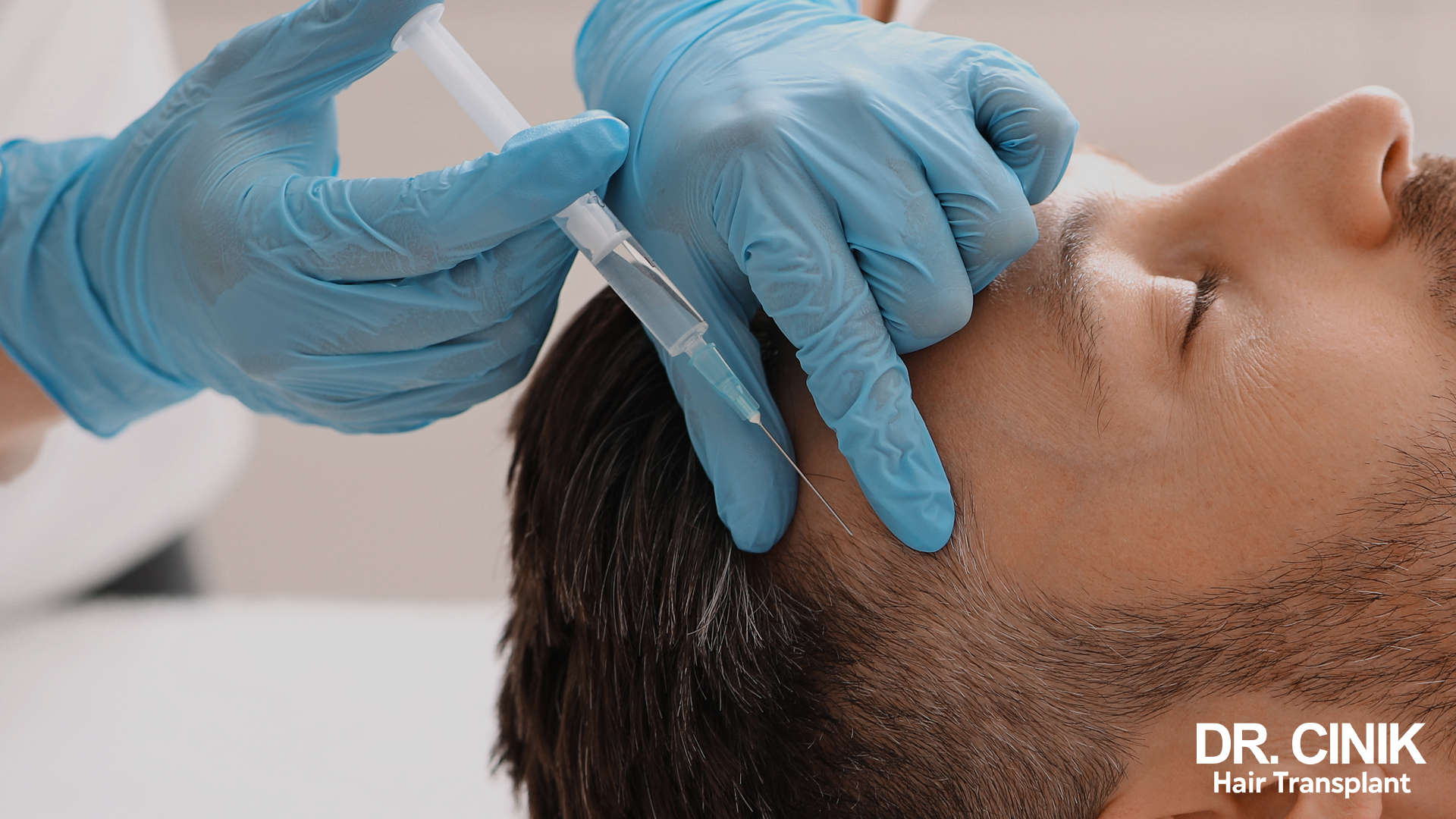
- Low-level laser therapy (LLLT) represents a new non-invasive, painless approach to treating androgenetic alopecia. Laser diode devices emit red light that penetrates the scalp, locally increasing ATP production in mitochondria, stimulating microcirculation and enhancing hair follicle metabolism. Clinical studies have shown the efficacy and safety of the Hairmax laser comb, equipped with 655 nm diodes to be used 3 times a week. After 26 weeks of treatment, hair density and the number of hairs in the anagen phase were significantly increased. Other devices like the iGrow Hair helmet or the Theradome LH80 PRO offer similar results.

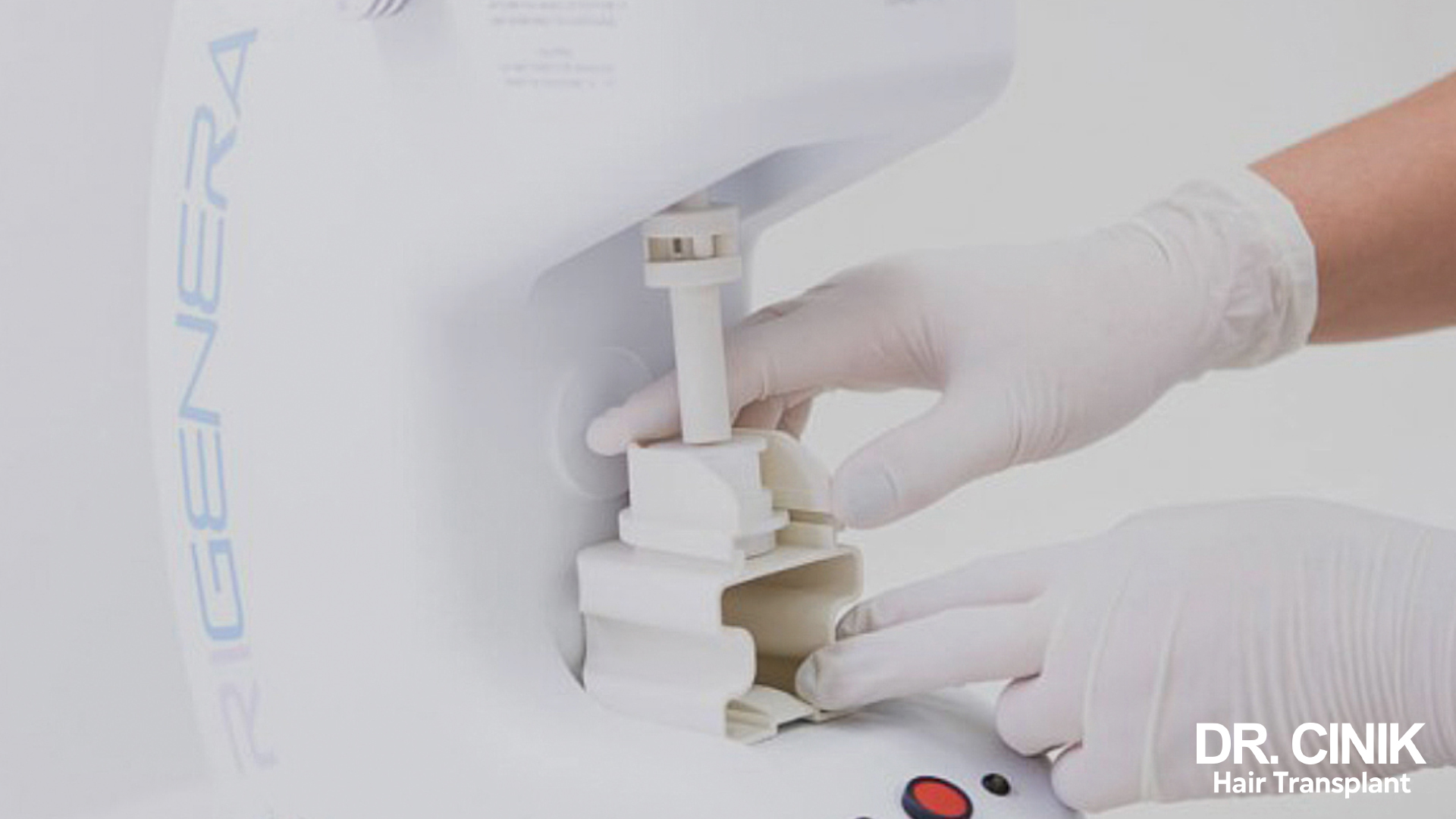
Dietary Supplements and Natural Products
- Certain dietary supplements can be useful in addition to medication to slow hair loss and promote regrowth. Supplementation with B vitamins (B7 or biotin, B6, B12), iron and zinc is often recommended in cases of deficiency. Vitamin D also plays a key role in the hair cycle via the vitamin D receptor (VDR) expressed in hair follicles. Studies suggest that low vitamin D levels may promote androgenetic alopecia.
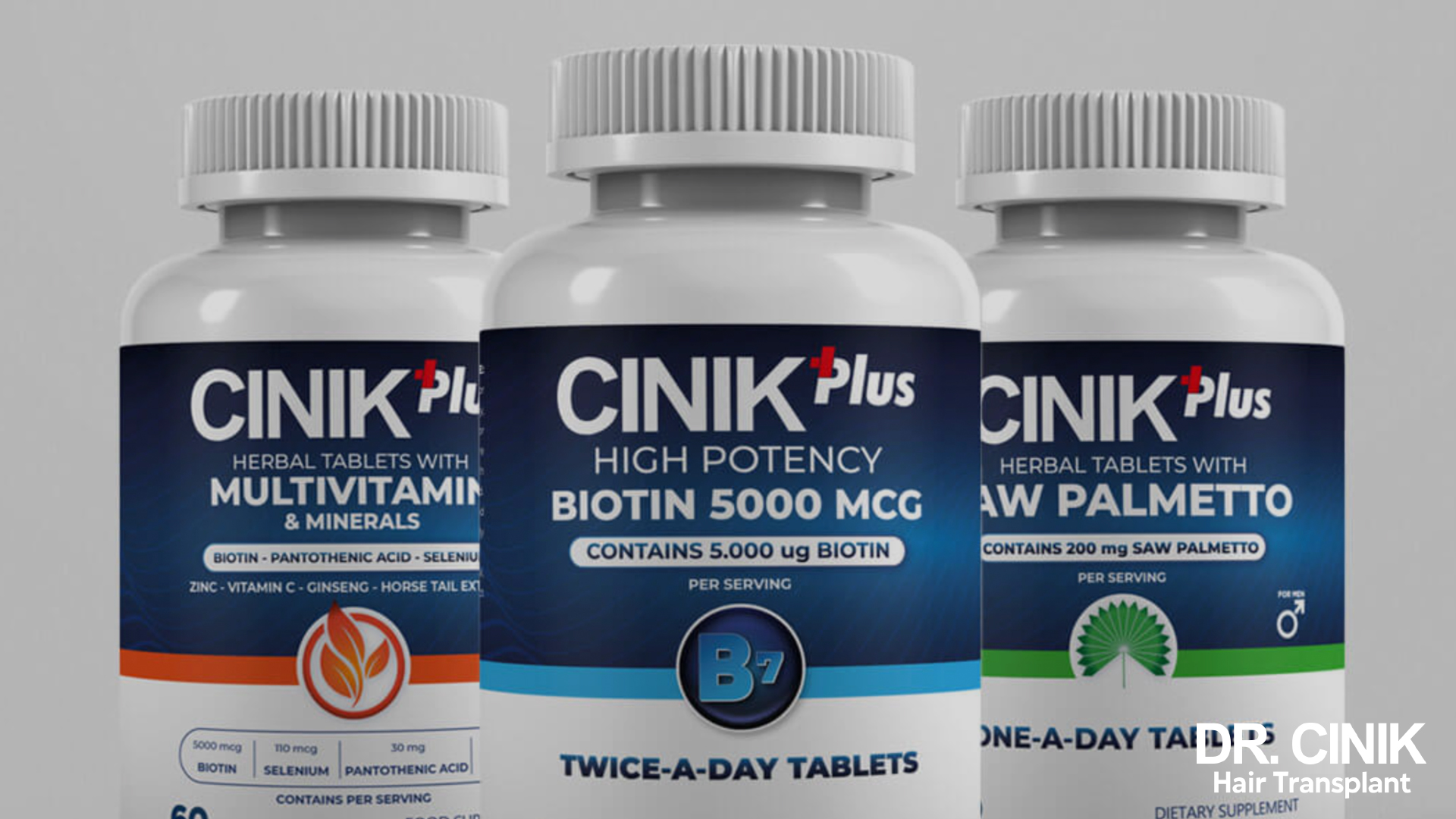
- Plant extracts are frequently offered in capsule or powder form for their hair loss-reducing and growth-stimulating properties:
- Saw palmetto (Serenoa repens) and pumpkin seeds are reputed to inhibit 5-alpha reductase and lower DHT levels.
- Green tea contains catechins like epigallocatechin gallate (EGCG) with anti-androgenic effects.
- Licorice root extract, rich in glabridin, may increase blood flow to hair follicles.
- Melatonin, capsaicin or curcumin may promote regrowth by stimulating circulating growth factor levels (IGF-1, VEGF).
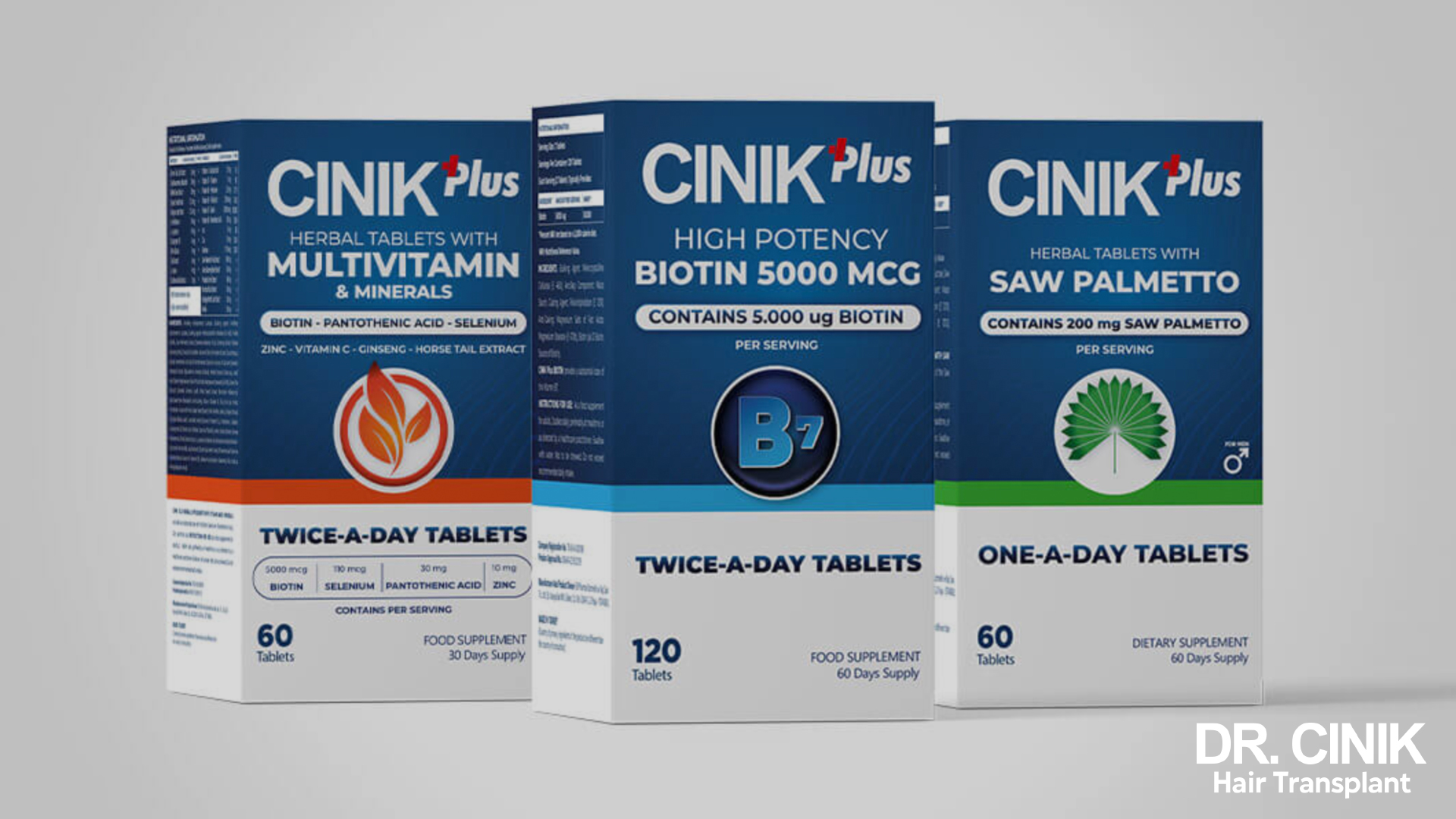
- Many anti-hair loss cosmetic products based on plants are marketed as lotions, serums or shampoos, but their true clinical efficacy is often debatable due to a lack of rigorous studies.
- Shampoos containing essential oils of rosemary, peppermint and thyme may slow shedding.
- Clary sage essential oil and willow bark extract may stimulate regrowth.
- Nasturtium extract may promote hair anchoring thanks to its richness in vitamin B.
- Serums containing copper tripeptide or Redensyl® (lentil and green tea extract) may help thicken hair.
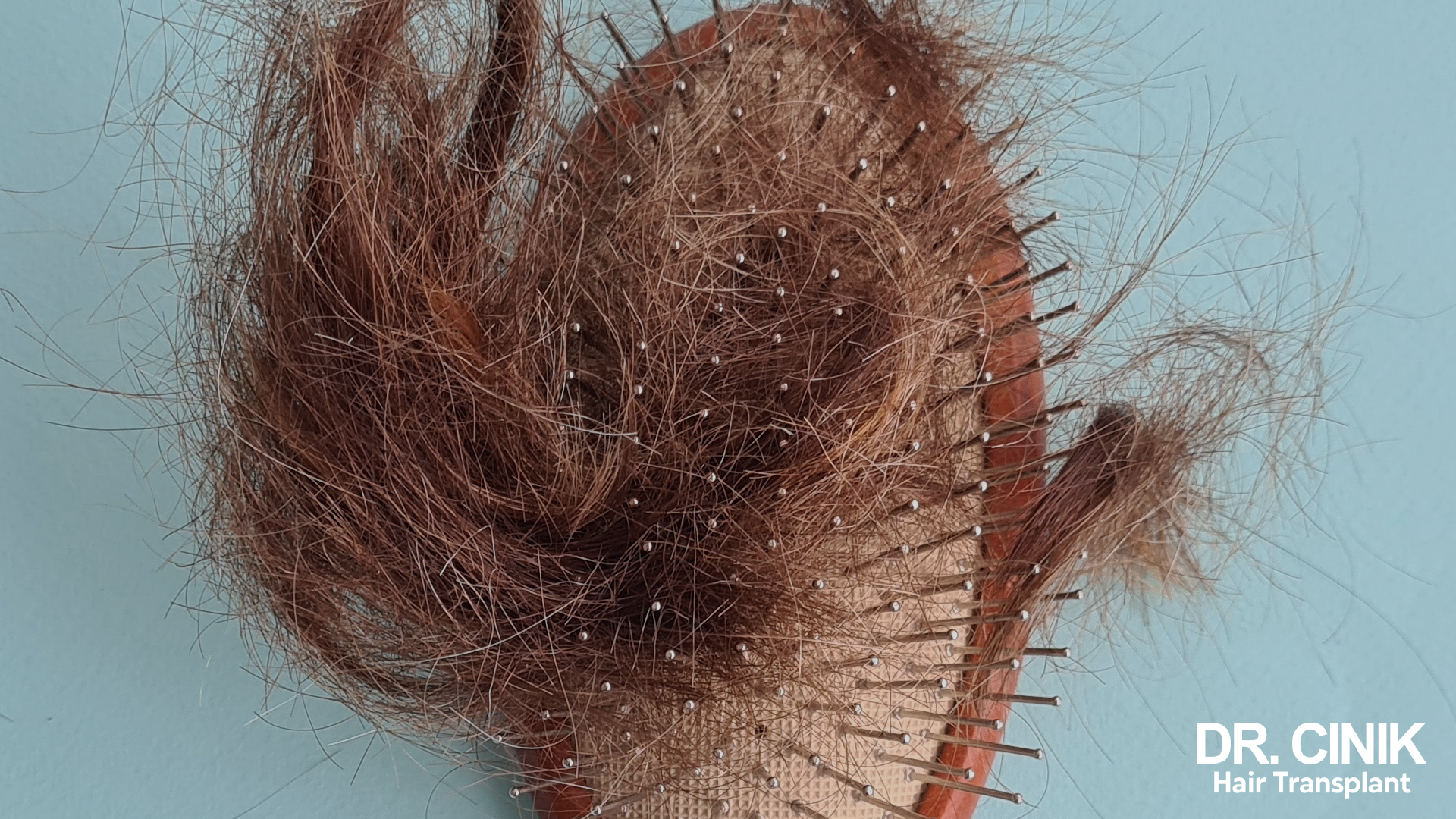
Hair Transplantation: An Effective Solution for Significant Hair Loss
When androgenetic alopecia is already quite visible, hair transplantation is the best option for lasting hair restoration. It involves harvesting hair follicles one by one from the DHT-resistant areas of the scalp – the donor zone at the back of the head – using a 0.7 to 1 mm diameter punch, then reimplanting them in the affected recipient areas. Harvesting is now performed using the FUE (follicular unit extraction) technique, where each graft contains 1 to 4 hairs and leaves a barely visible scar. The DHI (direct hair implantation) technique allows grafts to be implanted one by one using an implanter pen without prior incision for a very natural result. Hair transplantation can thus definitively restore hair in cases of extensive alopecia, whether male or female. It is particularly recommended for men with stage 3 to 6 alopecia on the Norwood scale (though this can vary and eligibility is determined by the surgeon), and for women with significant hair loss on the vertex.
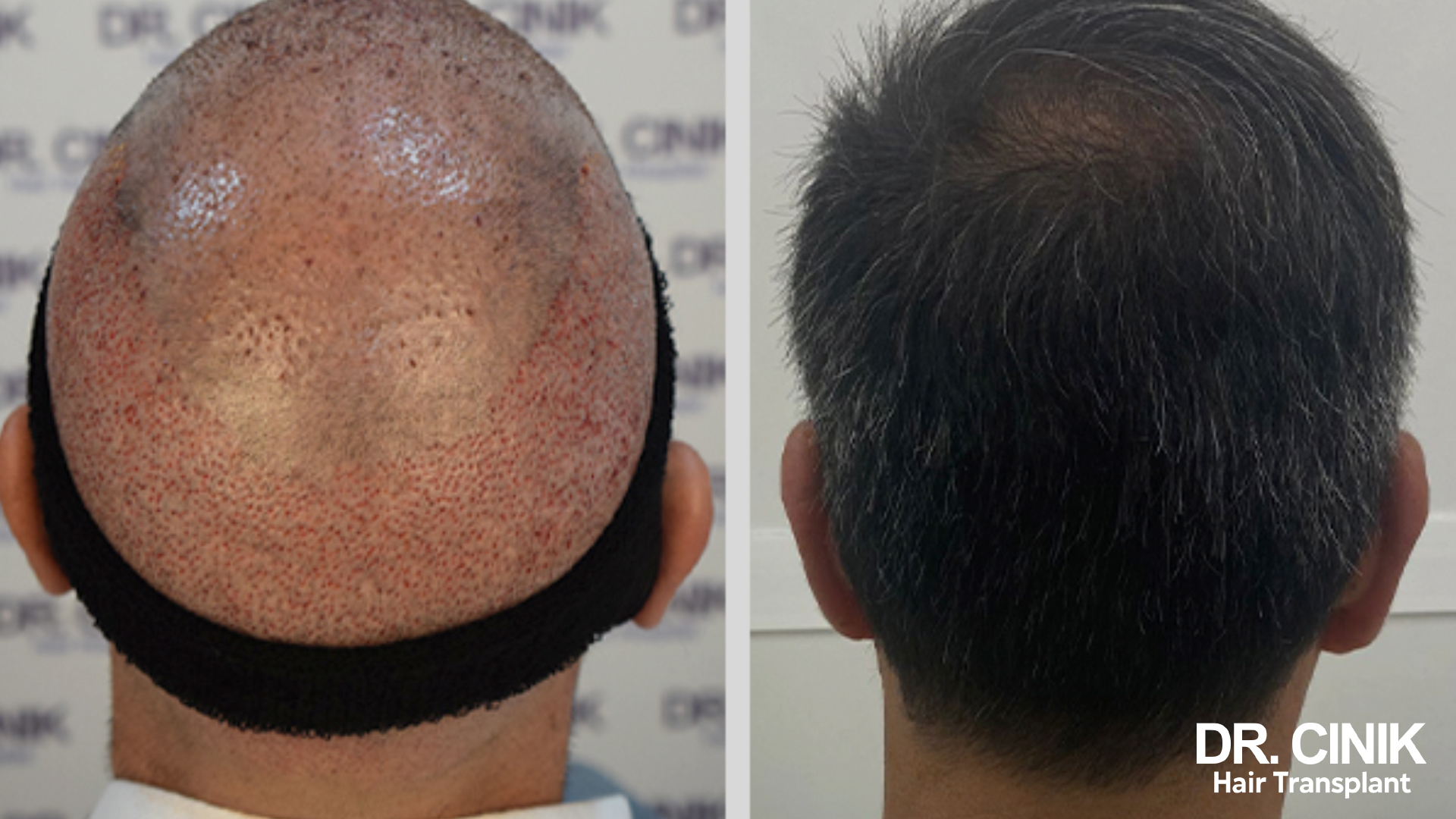
Hair Transplantation in Turkey: A More Affordable Option
While hair transplantation remains a costly procedure in many countries, it has become much more accessible thanks to the development of medical tourism in Turkey. An increasing number of patients are choosing to travel to Istanbul to benefit from the expertise of Turkish surgeons at a competitive price.
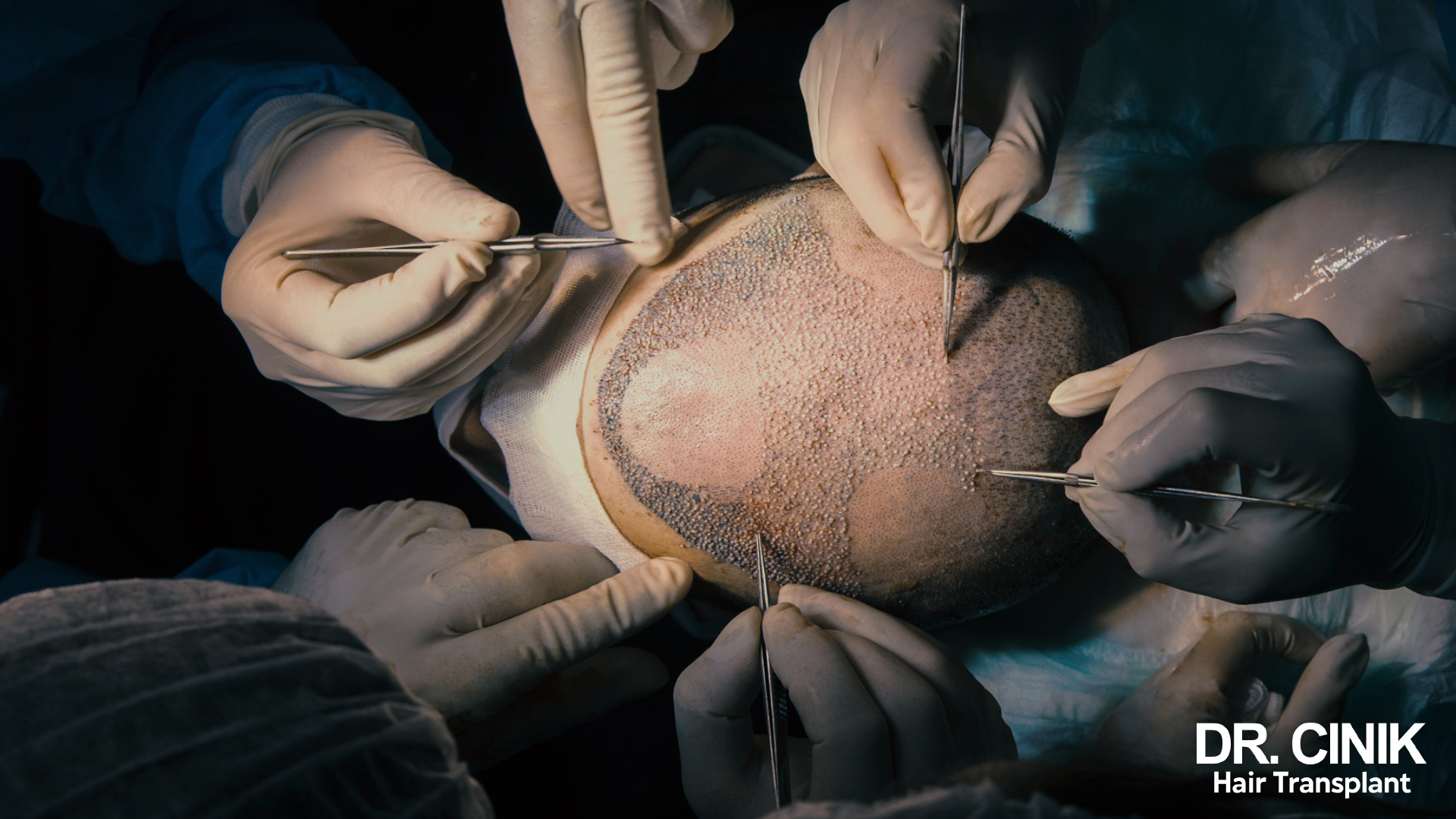
Why More and More Patients Are Choosing Turkey for Transplantation
Turkey, and particularly Istanbul, has become a leading destination for hair transplantation in recent years. Several factors explain this popularity:
- The know-how and experience of Turkish surgeons in the field of hair transplantation. They perform a large number of procedures each year and have mastered the latest techniques.
- State-of-the-art specialised clinics equipped with the most modern technologies and applying strict protocols to ensure patient safety and comfort.
- Very attractive prices, up to 70% cheaper than in Western European countries, without compromising on quality of care. This difference is due to the lower cost of living and overheads in Turkey.
- The quality of the reception and services with all-inclusive packages, including airport transfer, accommodation in a 4 or 5-star hotel, and the assistance of an interpreter.
- The possibility of combining the procedure with a touristic stay in Istanbul, a city with a rich historical and cultural heritage.

The Advantages of Turkish Hair Clinics: Costs, Expertise, Care
Istanbul clinics, like Dr Cinik’s, offer fixed-price hair transplant packages regardless of the extent of baldness and the number of grafts required. These packages include all services for a clear, transparent price:
- The procedure performed by an experienced surgeon (Dr Cinik has over 25 years of experience and has already performed over 15,000 transplants).
- The use of the most recent, least invasive techniques (FUE, DHI, implantation with Sapphire blade…) for a natural result.
- A guaranteed personalised treatment by a French-speaking team and rigorous post-operative follow-up with treatments optimising regrowth, PRP, laser or Regenera Activa.
- A stay in high-end accommodation and private vehicle transfers for optimal comfort.
With an average price of €2,500 for an FUE transplant and €3,000 for a DHI transplant, getting a transplant in Turkey allows for substantial savings compared to European clinics, without sacrificing quality.
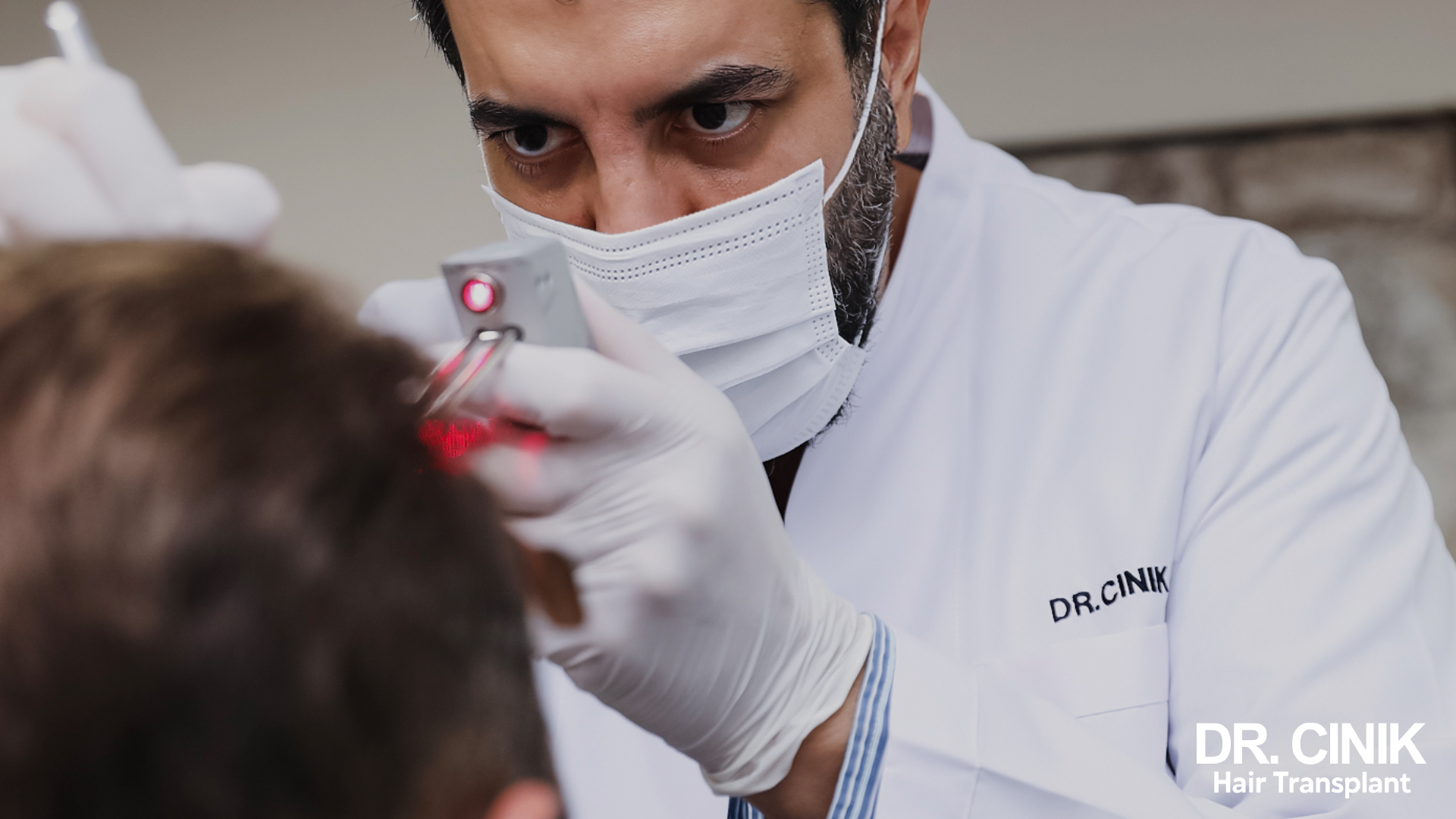
In Conclusion
Androgenetic alopecia is a progressive, hereditary form of hair loss linked to the harmful action of DHT, a testosterone derivative, on genetically sensitive hair follicles. This hormone shortens the hair growth phase and leads to a gradual miniaturisation of the affected follicles.
Sensitivity to DHT depends mainly on genetic factors but can be exacerbated by hormonal imbalances and other elements such as ageing or stress. Several treatments exist to counter the effects of DHT and promote regrowth: anti-androgen medications, topical solutions like minoxidil, dietary supplements, PRP, laser…

When hair loss is already well advanced, hair transplantation is the most effective solution for lasting hair restoration. This increasingly popular procedure involves harvesting DHT-resistant hair follicles from the sides and back of the scalp and reimplanting them in the balding areas. It allows a natural density to be restored.
Among the popular destinations for hair transplantation, Turkey has established itself as a leader. Its specialised clinics attract an international clientele seeking quality care at competitive prices. In Istanbul, Dr Cinik is considered an expert in hair transplantation thanks to his 25 years of experience and sense of innovation. He offers high-end medical treatment and support at prices up to 3 times lower than those in France.

 en
en



